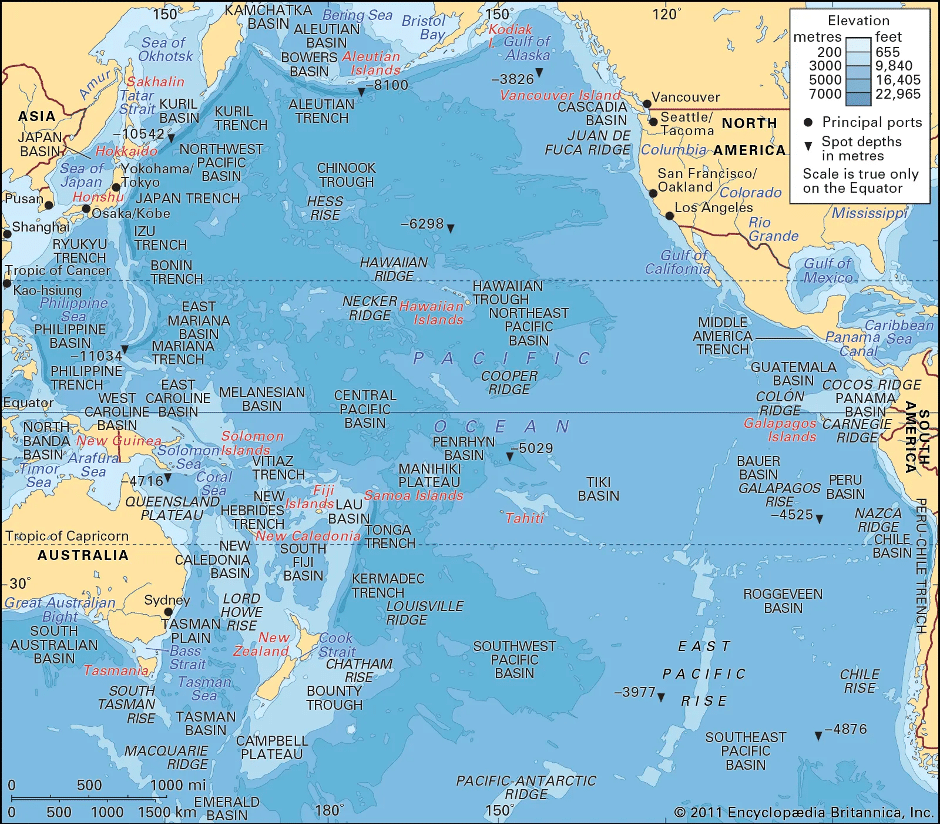Pacific Ocean: a Detailed Map

Even if the ocean is actually one huge body of saltwater, connected throughout the globe (the Global Ocean), human beings have divided it into five main basins based on historical, geographical and cultural factors. These oceanic basins are known as Pacific, Atlantic, Indian, Arctic and Southern. Combined, all these bodies of water cover about 71% of the planet’s surface and contain about 97% of all the water on Earth.
Once you know this, it is our duty to find out all the information we can about our ocean, including its surface area, volume, depth and much more.
In this article, we will look specifically at the Pacific Ocean, one of the three biggest bodies of water on the planet. We will not only talk about its position, details and geology, but will also learn about its ecosystems and biodiversity, the essential role they play in the balance of all life on Earth, and what we can do to protect it from the threats it is currently facing.
Keep reading if you want to learn all you need to know about the Pacific Ocean!

Image: Encyclopædia Britannica, Inc.
How big is the Pacific Ocean
The name “Pacific” comes from the fact that Portuguese explorer Ferdinand Magellan, during his journey to the Philippines, found the Ocean very peaceful.
As we just mentioned, the Pacific is one of the three major oceans (the other two are the Atlantic and Indian). However, it does not end there. The Pacific Ocean is actually by far the largest of all bodies of water, occupying almost 30% of the Earth’s surface.
It covers 165,250,000 square km (63,800,000 sq. mi), roughly 46% of the water surface on the planet.
The Pacific Ocean has double the area and more than two times the volume of the Atlantic, which is the next largest. One curious fact is that the area of the Pacific actually exceeds that of all land surface on the globe!
North to South, the Pacific Ocean stretches from the Bering Strait, where it connects to the Arctic Ocean, to the Southern Ocean. It is also connected to the Indian Ocean around Sumatra close to the Strait of Malacca and, in the East, to the Atlantic Ocean by the Strait of Magellan and the Drake Passage. Its greatest latitudinal extent is about 19,000 km (12,000 miles) between the coast of Colombia and the Malay Peninsula.
How deep is the Pacific Ocean
The average depth of the Pacific Ocean is 4,280 m (14,040 ft), and it contains the deepest known spot on the planet: Challenger Deep in the Mariana Trench, east of the Philippines, at 11,034 m (36,201 ft.).
An Oceanic Trench is a long and narrow topographic depression of the ocean floor that is usually found at the convergence of plate tectonics.
The Mariana Trench’s length is more than 1,500 miles (2,550 kilometers) and it is 43 miles (69 kilometers) wide. Curious fact? Mount Everest would fit in the Challenger Deep with over a mile to spare!
Another is that most of the world’s active volcanoes are underwater and are all located in an area in the Pacific Ocean called the “Ring of Fire“.
Climate
As most part of the Pacific Ocean is found in low latitudes, its climate is mostly tropical and subtropical.
In the Eastern Pacific, there are two subtropical, semi-permanent high-pressure cells. These are defined oceanic because they are found mostly over the ocean (even if they have great influence on the weather of the adjacent land), and semi-permanent because they move little from day to day. The air moving around them also affects the currents of the surface waters of the ocean.
Did you know that in the Northern Hemisphere the winds and surface waters move clockwise, while in the Southern Hemisphere they move counterclockwise, resulting in trade winds on the equatorial sides, and westerlies on the polar sides. As they move towards the equator, the trade winds (or tropical easterlies), which are the strongest winds on Earth, pick up great quantities of moisture from the sea. These currents are warm, while the currents driven by the westerlies are cold.
Despite its name, the Pacific Ocean often experiences tropical cyclones, or typhoons (called hurricanes in the North Atlantic and the eastern North Pacific). Tropical cyclones occur in greater numbers in the western Pacific than hurricanes in the Atlantic, and they generally cause more damage.

Salinity
Wind, precipitation and evaporation patterns greatly influence the salinity of the surface waters of the Pacific Ocean.
Usually, the waters found in the belt of calm winds near the Equator have lower salinities than those in the trade-wind belts. This is because near the Equator, relatively large amounts of rain fall and little evaporation occurs; salinity here runs as low as 34 parts per thousand.
On the other hand, salinity can reach 37 parts per thousand in the open southeastern areas, while the lowest salinities (less than 32 parts per thousand) occur in the far north of the Pacific.
Temperature
The ocean tends to be stratified, and one of the main factor for this is its temperature: the bottom waters in the deepest parts, which contain about 80% of the ocean’s volume, are intensely cold, with temperatures just above freezing, usually around 3.5 °C (38.3 °F). Temperatures here are usually quite stable.
In the surface zone, up to a depth of around 300 meters (1,000 feet) temperature variations are perceptible.
Usually, ocean temperatures in the North Pacific are higher than those in the South Pacific because land to sea ratio, and because Antarctica and the Southern Ocean influence water temperature.
Physiographic Regions
The Pacific water basin is often conveniently divided into three major physiographic regions: the eastern, western, and central Pacific regions.
Eastern region
The eastern Pacific region stretches southward from Alaska to Tierra del Fuego. It is relatively narrow and is associated with the American cordilleran system of mountain chains, which rise steeply from the western shores of both North and South America.
The most important oceanic trenches in this region are the Middle America Trench in the North and the Peru-Chile Trench in the South Pacific.
Western region
The western Pacific region is separated from the eastern by a line of oceanic trenches, which extends from the Aleutian Trench in the north, through the Kuril and Japan trenches all the way to the Tonga and Kermadec trenches, ending close to the northeast of North Island, New Zealand.
Its structure is more complex than that of the eastern region. The many islands in this region, including that of Japan, are the upper parts of mountain systems that rise steeply from the deep ocean floor.
Central region
The central Pacific region is found between the boundaries of the eastern and western regions. This is the largest and the most geologically stable of the structural areas of the Earth’s crust, and is characterized by huge areas of low relief, lying at a general depth of about 4,600 metres (15,000 feet).

Biodiversity
The Pacific has the most diverse marine biodiversity of all the world’s oceans. This is because the currents that go through the southern and northern polar waters of the Pacific permit the mixing of life forms coming from other oceanic regions.
One of the main features of this variety is given by the kelp beds found on the rocky cold-water coasts of North and South America. These forest like environments are home to a rich variety of marine life, from invertebrates to fishes, and have an animal biodiversity almost as diverse as that of the rainforests.
In the tropical climates of the Western Pacific, the wealth of marine animals obviously increases exponentially, and here we can find the richest and most extensive coral reefs of any ocean.
Whales, sea turtles, sea otters, and sea lions are a prominent and spectacular component of Pacific marine life. The Pacific is also home to many kinds of fishes.
Geology
Research has shown that all the major features of the Pacific Ocean floor and the land that surrounds it originate in plate tectonics.
For example, the arcs of volcanic islands and deep trenches in the Western part of the Pacific are convergent zones where two plates are colliding, forcing one under the other.
On the other hand, the East Pacific Rise is an active spreading center, which is where new crust is created.
In the southeastern Pacific, the Nazca Plate and the South American Plate collide to form the Andes Mountains and, a short distance offshore, the Peru-Chile Trench. The floor of the northeastern Pacific is known for its various fracture zones, which, in some cases, are identifiable over great distances. The tropical islands of the Pacific are mostly coralline.
Mineral resources
The Pacific Ocean contains enormous mineral resources of which only a few have been exploited, like salt, bromine, and magnesium. Minerals can be extracted from the seawater itself, from alluvial deposits, or from the continental shelf. Underwater exploration for oil has also occurred near Vietnam, the Philippines, Indonesia, California, Russia, and China. There are also known deposits of natural gas in the continental shelf of both the northern and southern hemispheres.
Fresh water can also be obtained from the ocean, by various methods of desalination, as is done in Japan.
Threats
As the whole Global Ocean, the Pacific is under threat. In the last few decades scientists have proved that, despite its vastness, the ocean is not immune to human impact. Our technologies and habits have devastating effects on marine ecosystems.
Great Pacific Garbage Patch
One of the main issues is marine pollution, be it plastic, oil or of other kinds. In the pacific, we find the so-called “Great Pacific Garbage Patch”, a massive plastic accumulation area found at the center of an ocean gyre (a rotating ocean current). This is mostly caused by littering and marine debris discharged in the sea, intentionally or not.
Overfishing
Another serious threat to the balance of the Pacific Ocean is overfishing and illegal fishing practices. As mentioned above, this body of water is home to a great variety of sea-life and at least six endangered species that are at the mercy of hunters and by-catch.
These animals depend on the balance of the ocean ecosystem to survive, which is being disrupted by fishing practices.
References
https://www.britannica.com/place/Pacific-Ocean
https://www.nationalgeographic.com/environment/article/pacific-ocean
https://oceanexplorer.noaa.gov/facts/pacific-size.html
https://oceaninfo.com/list/pacific-ocean-facts/
https://www.geographyrealm.com/geography-facts-about-the-pacific-ocean/
https://lisbdnet.com/what-is-the-climate-in-the-pacific-ocean/


